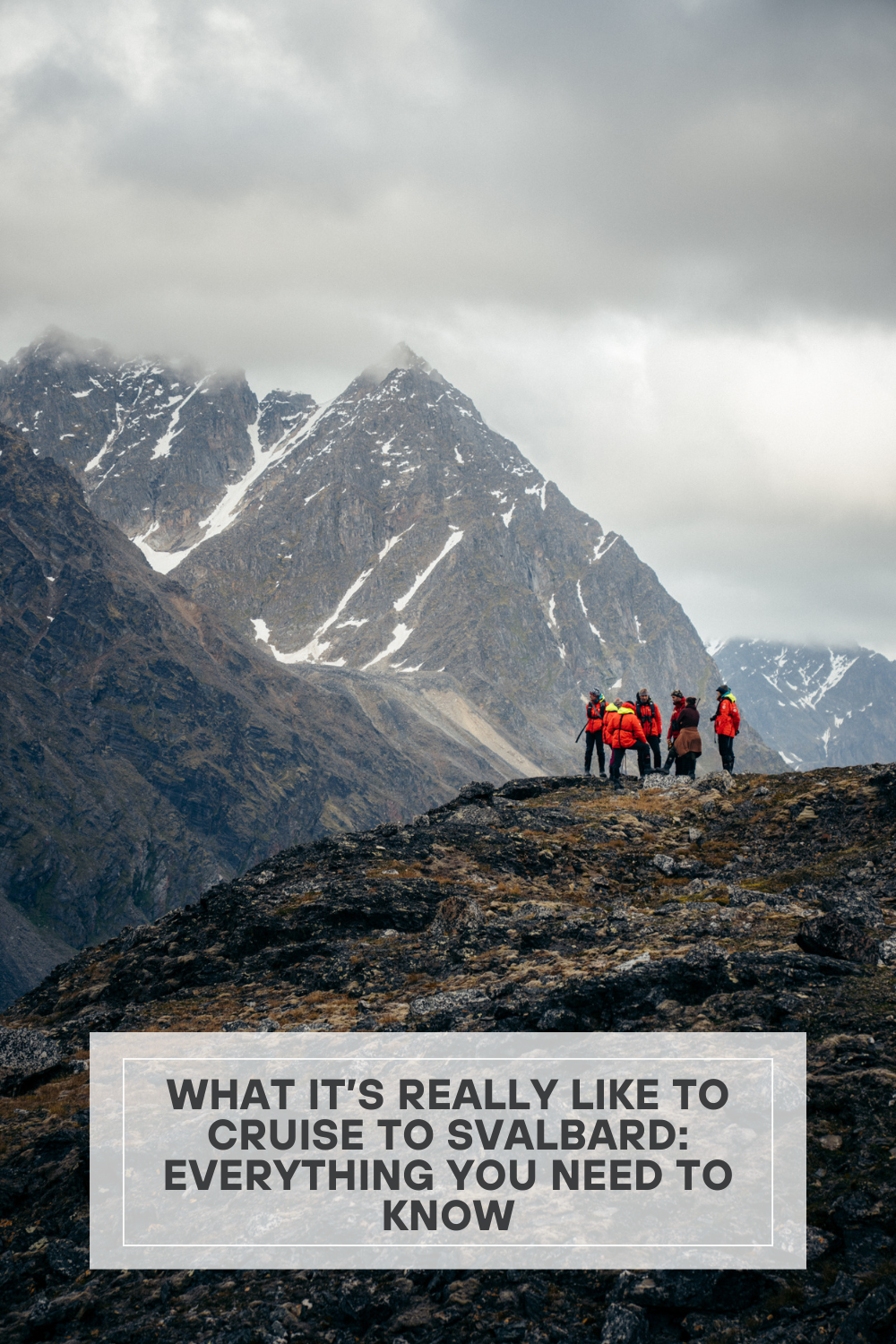What it’s really like to cruise to Svalbard: Everything you need to know
I just returned from a week in the Arctic on a mini cruise aboard Hurtigruten's Serenissima. The Arctic has been a long-held dream of mine to visit, so when I saw a mini cruise option, I jumped at it. Why the mini cruise option? I get motion sickness quite easily, and I wasn't ready to commit to a longer time on board a ship without knowing how I would handle it.
The cruise was a journey through glacial landscapes, historic outposts, and moody Arctic light. This wasn't a wildlife-centered trip as I had previously assumed. If you're dreaming of polar bears and walruses filling your frame close-up, you need a different kind of cruise on a smaller vessel that will venture deep into the pack ice.
This post breaks down our itinerary by day, wildlife encounters from a larger boat, and tips for photographers or travelers considering a similar route or this cruise.
Longyearbyen
We started our journey with an overnight stay at the five-star Funken Lodge in Longyearbyen. This cozy lodge exceeded our expectations in every way and was conveniently located for an easy walk into town to explore. Longyearbyen has a fascinating history. It was initially a mining community named after American John Monroe Longyear, who opened the first coal mine there in 1906. Mining continued to be one of the primary sources of income until approximately two weeks ago (end of June 2025), when mine #7 was officially closed, and the final truckloads of coal were being shipped to Germany.
Colorful homes in Longyearbyen
Now, Longyearbyen is considered a modern town with a population of approximately 2300. This includes children, students, and adults who live there year-round. Tourism and research are the two primary areas of focus that drive the local economy. Many college students find themselves studying in Longyearbyen and end up staying for several years, having been bitten by the "Arctic bug".
Fun Facts
Due to the permafrost, there is a law that you cannot die (or give birth) in Longyearbyen. Anything buried will eventually make its way to the surface, yikes.
There are more polar bears throughout Svalbard than residents, roughly 3000.
The streets in Svalbard are not named.
The global seed vault is located in Svalbard.
Route
Day 1:
In the morning, we had a lovely breakfast at our lodge and had time to explore the shops in Longyearbyen before we were picked up in the afternoon. We took a tour of the local museum and spent an hour at Camp Barentz learning about sled dogs and polar bears. We finally boarded the Serenissima in the afternoon and set sail for Borebukta. As we came to a stop in front of the glacier in front of Borebreen, we spotted our first polar bear sleeping on one of the small islands in the far distance. After our spotting, we enjoyed our first dinner on board the ship.
Day 2:
Land excursion in Magdalenefjorden
We sailed into Magdalenefjorden, which is one of the most beautiful fjords on Spitsbergen. Spitsbergen translates to pointy mountains, which William Barents named when he discovered Svalbard in 1596. Sadly, this place was overrun with whale hunters in the 1600s, driving many of the whale species to the brink of extinction. We walked towards Gullybukta, where we saw a lone harbor seal hanging out on a rock near the shore.
Harbor seal resting on a rock
That afternoon, we anchored in front of the Smeerenburg glacier, hopping in zodiacs to explore it close up. Nowadays, Svalbard is 53% covered by glaciers, down from 60% previously, as this part of the world is warming at a rate seven times faster than anywhere else on the planet. From the zodiacs, you can take in the magnitude of the glaciers, hear the carvings hit the water, and the crackling of the ice floating in the water. This was one of my favorite experiences on the cruise.
That evening, we arrived at the 80-degree parallel, toasting to reaching a point so far north that few people ever see. Nearby, we saw a walrus colony at Moffen Island, enjoying watching them play and wiggle around the island.
Day 3:
We were supposed to sail to Liefdefjorden and Bockfjorden, but due to high wind gusts and big waves, we went to Krossfjorden to avoid the bad weather. We woke to an announcement on the loudspeaker that three polar bears had been spotted in the distance by the deckhand: a mother and her two cubs, aged one and a half years old. After breakfast, we lined up to go to shore at Signehamna, but due to the winds and waves, our morning landing was cancelled.
Tinayrebukta
The afternoon found us at Tinayrebukta for a successful landing. On shore, we watched a few seals who were intrigued by our presence. We did a longer hike, scrambling up the hillside that had sweeping views of the fjord. After the hike, it was time to take the polar plunge, wading into the 4 °C water. That evening, we saw the polar bear family again walking along the shoreline and got to watch them for quite a while. On the way out, the sun appeared as we passed the bird mountain, Cardiopynten.
Polar bear mom and her two babies, a year and a half old
Day 4:
On our last full day on board, we had breakfast in front of the Blomstrand glacier. Later that morning, we found ourselves exploring the southern side of Blomstranhalvoya to see the protected remnants of the former New London Company, established to mine marble. Though marble can be found everywhere you look, the moment it leaves the cold weather, it crumbles into dust, aka, ice marble. An expensive lesson Ernest Mansfield learned after his failed marble mining venture in 1911. Although Mansfield was fired in 1913, the company continued mining until 1928. Eventually, most of the equipment and cabins were relocated across the sound to Ny-Ålesund.
Ny-Ålesund is the world's most northerly community and was our second stop of the day. It's a former mining village that has evolved into an international research center, focusing on the atmosphere and ozone layer, while also encompassing geological, biological, and glacial research. For a small community, it's home to a great deal of history.
In 1926, Norwegian explorer Roald Amundsen, alongside American Lincoln Ellsworth and Italian Umberto Nobile, set out on a successful expedition to fly over the North Pole in the airship "Norge" from Ny-Ålesund. Between 1945 and 1962, the area experienced its second mining boom. Unfortunately, this period ended with the tragic loss of 70 lives in the dangerous mines. The coal layers in Ny-Ålesund are almost vertical, which causes gases to develop in the mines, leading to potential explosions. The last blast in Esther Mine resulted in the loss of 21 lives, leading to the resignation of Prime Minister Gerhardsen and his government and the permanent closure of the mines.
After our time in Ny-Ålesund, we boarded the ship for one last dinner on board before returning to our rooms to pack up for our early morning departure the next day.
Photography Tips
If you're planning an Arctic cruise on a larger boat like the Serenissima, I recommend a longer lens, preferably one with a focal length of 600-800mm. The wildlife you will encounter on these journeys will be very far away, so having a long lens is key. My 400mm was not nearly long enough for the polar bears and walrus sightings we had.
For birders, there are numerous opportunities to photograph birds native to the Arctic. There are even puffins flying about if you're lucky enough to catch one on camera from the boat. Most of the imagery features vast glaciers, some of which are incredibly bright blue, while others resemble volcanic mountains with melting snow. If the weather cooperates, you can expect a mix of foggy and sunny days. When the sun comes out, it highlights the turquoise hue of the water that almost seems unbelievable when you're staring at it in person.
Just look at the water color!
Since most of the days were overcast for us, I didn't use my polarizing filter. However, if you have more sunshine than we did, you can try photographing with it on to enhance the sky and reduce any glare on the water. I had also brought an extender, but truth be told, when I used it versus just using my preset 1.5 crop in-camera, the images were unusable. I had better luck sticking with the in-camera crop feature with my 400mm on.
Lastly, make sure you have a waterproof camera bag or cover for it. For rainy days, consider bringing a bag to cover your camera if you're concerned about it getting wet. I would usually wear my camera under my jacket when it was raining. You'll also want a sturdy harness for the hikes.
On Board
The Serenissima holds around 100 on board. We booked a superior twin cabin and ended up in the very front of the ship on the 4th floor, which, if you suffer from motion sickness, is not where you want to be. When booking, be sure to let them know if this is an issue for you.
Our superior twin, basic but comfortable.
Amenities:
• Shampoo & bodywash in the shower
• Hair dryer in the room
• Two outlets plus one USB port for charging in the room
Food & Drink
Three meals a day were included with our booking. Breakfast and lunch were typically served buffet-style, while dinner featured a la carte options, including meat, fish, and vegetarian options. Coffee, tea, and water were included; anything else you had to pay for before you departed on the last day. Pro tip: Get in line early on the last day before the whole boat is trying to pay a bar tab to one office attendant.
In the bar area, coffee, tea, and water are always available, as well as cookies and, occasionally, an afternoon snack before dinner. If you like to have nibbles or snacks throughout the day, you can grab these at the Coop in Longyearbyen before you board the boat.
Wildlife Expectations
As mentioned earlier, this trip isn't primarily focused on wildlife. If you are lucky, you will see reindeer, seals, polar bears, and walrus from a distance. One of our guides mentioned it's not uncommon for them to have a cruise where they don't see any polar bears. It's truly a matter of luck. Your best chance of seeing anything is by spending as much time as possible on the decks and scanning the water. When someone spots something big, like a polar bear, they will usually announce it on the loudspeaker so you can go outside to experience it. We were fortunate to see polar bears three different times, with our last sighting being the most memorable.
Family of walrus near the 80th parallel on Moffen Island
Packing for a summer Arctic cruise
The ship will provide you with waterproof boots and a red jacket, which you are required to wear during landings. I found that with all of my layers on during hikes, I was super warm and ended up removing my jacket and/or fleece if I had it on. By the last day, I was wearing regular Lululemon leggings under my waterproof pants and one wool shirt under my jacket. Our temperatures ranged from 0 to 5 degrees Celsius, or 30s to 40s Fahrenheit, in early July. Ultimately, the wind and rain will be the deciding factor.
Photo by Rachel Carter
Here is what I recommend packing for a summer arctic cruise (the ship will also send a recommended packing guide by season, but this is based on my personal experience):
• Wool layers (tops & bottoms)
• Waterproof pants/ski pants
• Wool socks
• One fleece/heavy sweater
• Medium to heavy-weight jacket (if you have warm base layers, the jacket the ship provides is warm enough, especially during hikes, so you don't need to double up)
• Gloves
• Hat
• Sunglasses
• Scarf (optional, but helps on windy days to cover your face)
• Sleeping mask (remember, 24-hour light)
• Sturdy hiking boots
• Comfortable shoe for the boat, either a Birkenstock-style sandal or sneakers you can get in and out of easily
• Dramamine in case of motion sickness (there are also puke bags in the room)
• Scopolamine patches-for those who suffer extreme motion sickness like me, talk to your primary care doctor about these patches. They have been lifesaving for me, and I didn't have any issues on this trip, despite encountering some very rough weather during two nights at sea.
• Camera gear + extra batteries (the cold will drain them quickly)
• Binoculars if you want to watch for birds or hunt for wildlife on the shores
• Waterproof camera bag
• Vacuum bags (you can grab these from Amazon; they worked great for my winter coat and other thick clothing items)
• Bathing suit for the polar plunge
• A book or activity for the downtime on board (you will lose cell and WIFI service the second day on board, and expect it not to return until your final day)
Final Thoughts
Once I let go of the idea that this cruise would offer close-up wildlife encounters, I found myself fully appreciating the experience for what it was: an opportunity to witness some of the most remote and dramatic landscapes on Earth at a relaxed pace. Travel for me is often fast, so having just two outings a day gave me space to slow down, watch the ever-changing Arctic light, and soak in the scenery from the ship's deck with a warm drink in hand.
Svalbard's history is fascinating-equal parts eerie and resilient. It's hard to believe people live here year-round, enduring months of polar night followed by the constant glow of midnight sun. The stories from past expeditions and settlements added depth to each landing, and I left with a greater appreciation for both the environment and the people who have dared to inhabit it.
Smeerenburg glacier
The ship's size was good balance: small enough to feel personal, yet large enough to handle the rough seas we encountered on a couple of nights. If you're a Type A planner, though, take this to heart: Your itinerary will be shaped by the weather. Some days landings are canceled entirely, and destinations you were anticipating may be bypassed for safer alternatives. Arctic travel demands flexibility, and going with the flow is essential.
Would I do it again? Absolutely. I now know a traditional expedition-style cruise like this is more my speed than a smaller, wildlife-focused one. After speaking with others who took those ultra-remote routes, I realized the trade-offs (significantly rougher seas, higher risk of seasickness, and much steeper prices) might outweigh the benefits for me. Some nights on those smaller ships required passengers to literally strap themselves into bed. So if you're weighing your options, comfort, weather tolerance, and budget are key things to consider.
Ultimately, this trip left a lasting impression on me. It wasn't about ticking off animals on a photography shot list; it was about the solitude and surreal beauty of the High Arctic.
Booking Information: https://hurtigrutensvalbard.com/en/svalbard-adventure-mini-cruise/ms-serenissima
Find this post helpful?
Pin it for later!


















